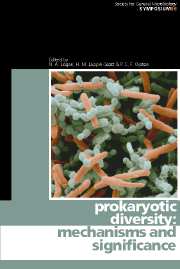Book contents
- Frontmatter
- Contents
- Contributors
- Editors' Preface
- Microbial diversity in the era of genomics
- Patterns in prokaryotic biodiversity
- A putative RNA-interference-based immune system in prokaryotes: the epitome of prokaryotic genomic diversity
- The significance of prokaryote diversity in the human gastrointestinal tract
- The genetics of phenotypic innovation
- Minimal genomes required for life
- Evolution of the core of genes
- Biogeographical diversity of archaeal viruses
- Is there a link between Chlamydia and heart disease?
- Unculturable oral bacteria
- Comparative genomics – what do such studies tell us about the emergence and spread of key pathogens?
- Spread of genomic islands between clinical and environmental strains
- Evolving gene clusters in soil bacteria
- Unusual micro-organisms from unusual habitats: hypersaline environments
- Genomic islands and evolution of catabolic pathways
- Horizontal gene transfer and its role in the emergence of new phenotypes
- Index
Unusual micro-organisms from unusual habitats: hypersaline environments
Published online by Cambridge University Press: 06 July 2010
- Frontmatter
- Contents
- Contributors
- Editors' Preface
- Microbial diversity in the era of genomics
- Patterns in prokaryotic biodiversity
- A putative RNA-interference-based immune system in prokaryotes: the epitome of prokaryotic genomic diversity
- The significance of prokaryote diversity in the human gastrointestinal tract
- The genetics of phenotypic innovation
- Minimal genomes required for life
- Evolution of the core of genes
- Biogeographical diversity of archaeal viruses
- Is there a link between Chlamydia and heart disease?
- Unculturable oral bacteria
- Comparative genomics – what do such studies tell us about the emergence and spread of key pathogens?
- Spread of genomic islands between clinical and environmental strains
- Evolving gene clusters in soil bacteria
- Unusual micro-organisms from unusual habitats: hypersaline environments
- Genomic islands and evolution of catabolic pathways
- Horizontal gene transfer and its role in the emergence of new phenotypes
- Index
Summary
INTRODUCTION
Thomas D. Brock defined extreme environments, considering that there are environments with high species diversity and others with low species diversity. Those environments with low species diversity, in which whole taxonomic groups are missing, are called ‘extreme’ (Brock, 1979). It is not easy to find a definition that is completely acceptable for all environments that are considered as extreme, but we observe that in some habitats environmental conditions such as pH, temperature, pressure, nutrients or saline concentrations are extremely high or low and that only limited numbers of species (that may grow at high cell densities) are well adapted to those conditions.
Hypersaline environments are typical extreme habitats, in which the high salt concentration is not the only environmental factor that may limit their biodiversity; they have low oxygen concentrations, depending on the geographical area, high or low temperatures, and are sometimes very alkaline. Other factors that may influence their biodiversity are the pressure, low nutrient availability, solar radiation or the presence of heavy metals and other toxic compounds (Rodriguez-Valera, 1988). With a few exceptions, most inhabitants of these environments are micro-organisms that are called ‘halophiles’. However, different groups can be distinguished on the basis of their physiological responses to salt. Several classifications have been proposed; one that is very well accepted considers the optimum growth of the micro-organisms at different salt concentrations.
- Type
- Chapter
- Information
- Prokaryotic DiversityMechanisms and Significance, pp. 223 - 254Publisher: Cambridge University PressPrint publication year: 2006
- 98
- Cited by

